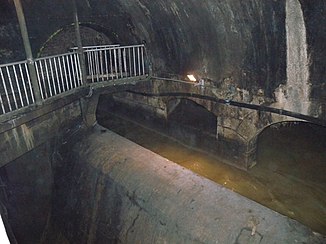Ottakringerbach
|
Ottakringerbach Sankt Ulreichspach |
||
|
In the area of the confluence of the Ottakringerbach in the left Wien river collecting canal is the so-called raid chamber , a location of the film The Third Man |
||
| Data | ||
| location | Vienna , Austria | |
| River system | Danube | |
| Drain over | Vienna River → Danube Canal → Danube → Black Sea | |
| source |
Gallitzinberg 48 ° 13 ′ 5 ″ N , 16 ° 16 ′ 1 ″ E |
|
| muzzle |
Vienna river coordinates: 48 ° 11 '59 " N , 16 ° 21' 58" E 48 ° 11 '59 " N , 16 ° 21' 58" E
|
|
| Big cities | Vienna | |
|
The source of the Ottakringerbach on the Gallitzinberg |
||
The Ottakringerbach (also: Ottakringer Bach ; formerly Sankt Ulreichspach ) is a derived Vienna Bach Canal with a source on the Gallitzinberg , which flows into the Wien River. It is the second longest Viennese brook.
history
Around 1449 today's Ottakringerbach was still called Sankt Ulreichspach . At that time it flowed along Liebhartstalgraben , then via today's Thaliastraße into Lerchenfelder Straße to Döblergasse, where it reached Neustiftgasse across the block at Augustinplatz. Near the St. Ulrichs-Platz it made a loop around the Neudeggerschloss and back to the Neustiftgasse and then continued over the Minoritenplatz, the Strauchgasse, the Tiefen Graben and the Concordiaplatz , whereupon it flowed into today's Danube Canal . In the area of the deep ditch, the brook was included in the ditch in front of the city wall of the former Roman camp Vindobona .
It was first diverted in the 13th century. It then ran in an artificial channel across the Getreidemarkt to the Wien River, into which it flowed at the Secession . A pencil mill was operated here until 1843.
In addition to drainage, the Ottakringerbach was also used to dispose of waste. Since animal carcasses are said to have been thrown into the water, the stream probably contributed to the outbreak of the plague and other diseases.
The final scene of the film The Third Man was shot in 1949 where the Ottakringerbach flows into Vienna today .
Floods and the consequences
After severe damage from floods, the brook was vaulted in 1729 . In the same year, the ineffectiveness of the measure became apparent during a flood.
During the great wave of canalization in Vienna in 1830 and 1831, a separate waste and overwater canal was built into which the Ottakringerbach was discharged; Parts of the old river bed were filled in. The next great flood in 1845 nevertheless caused devastation again.
In 1853 and 1862 the brook blew up its canal bed and caused considerable damage several times. Therefore it was diverted in 1874, so that it no longer flowed down into Neustiftgasse, but straight ahead along Lerchenfelder Strasse to Museumsstrasse.
See also
Web links
- The (in) visible brook - The Ottakringerbach in the Viennese cityscape - a search for traces ( Memento from June 1, 2010 in the Internet Archive ) (PDF; 388 kB)
- Entry on grey2green.wordpress.com , original source: Elfriede Faber 'Neubau' Edition Vienna 1995


